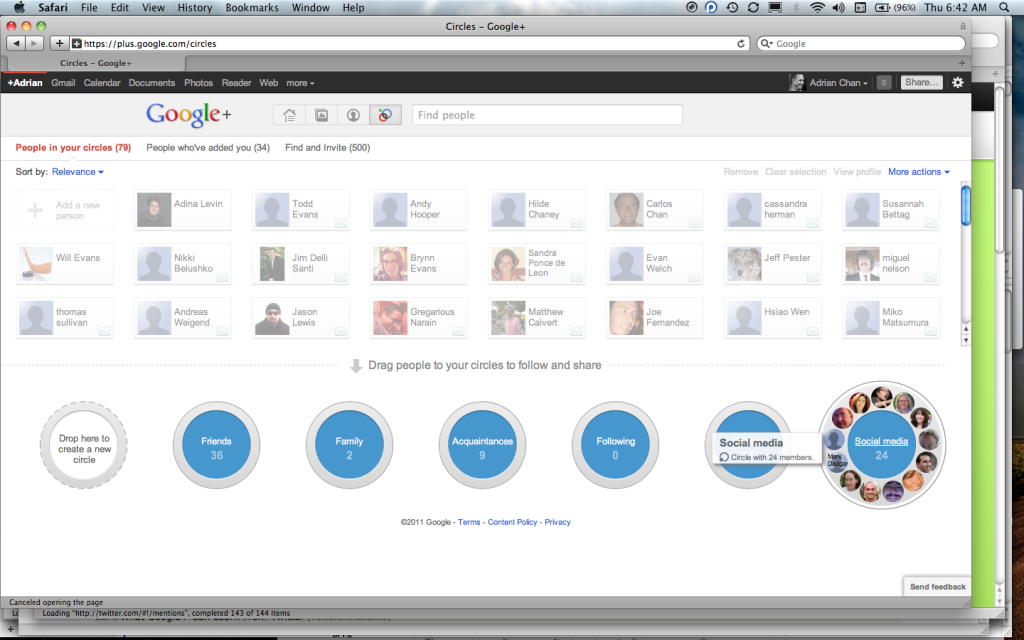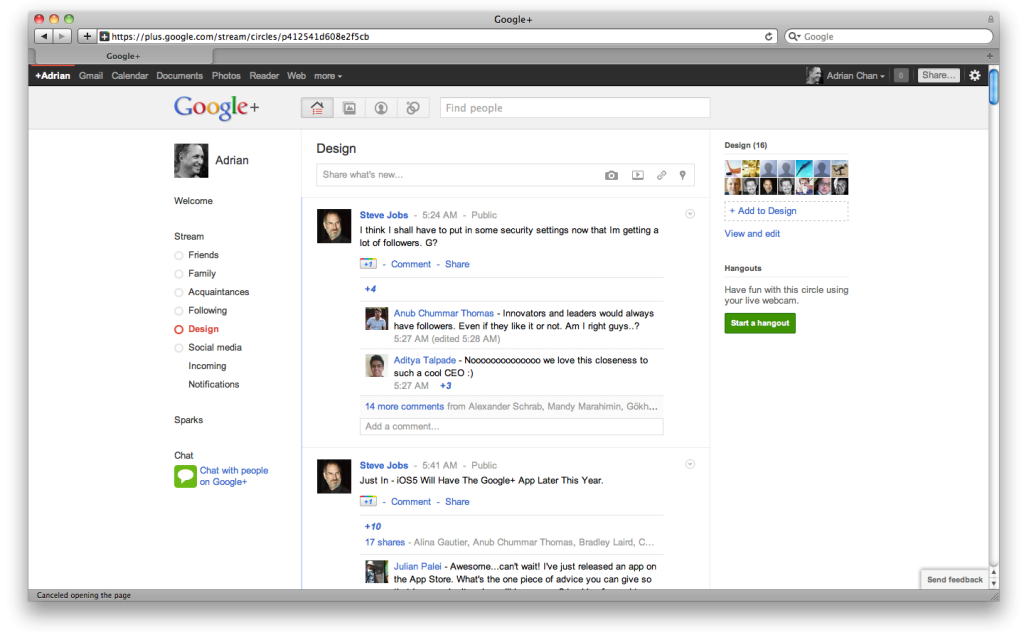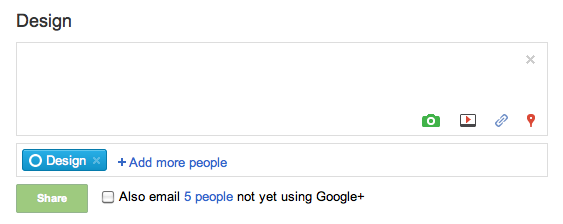So the paint is still wet on Google+, but I have had a chance to spend time in it and get a feel for how Circles have been implemented. As I wrote yesterday about social boundaries, and the awkwardness of forcing people to group friends, family, acquaintances etc., I can add a bit more today about Google’s implementation of Circles.
Circles seem at first to work as contact groups. You simply, and I must say very elegantly, drag and drop contacts onto circles. There are a few provided by default (family, friends, etc) but it’s very easy to create new ones. People can be dropped into multiple circles.
Each circle becomes a group name then shown on the left side of the home page view. In selecting a circle, you filter the stream. Updates from members of that circle are shown in the center panel. All of this feels like Facebook Groups.
When you select a circle to view by, the post element at the top of the page defaults to the Circle chosen (as seen here).
Now this is where it gets interesting, and potentially becomes a bit confusing. Up to now the Circle has acted as a filter on posts. So it works like a twitter list. The circle was defined by me, and so as in twitter, I an the only one seeing this feed.
But post feeds, particularly when they have comments, become conversational. This means that the circle of course is not a hard constraint on who I see in the feed. I see comments from others not in my circle, and not amongst my friends, etc. No real problem yet, I’m still having a Facebook groups/Friendfeed type of experience.
It’s where I elect to post to a circle that things get confusing. In choosing to post to a circle (in this case, Design has been added to the post element as I’m in my “Design” circle now), I’m posting as if to a group. But because the people in my circle haven’t joined this group, there’s no shared group experience. I am simply notifying members of my Design circle of the post.
This leads me to a couple concerns.
First, conversations in Google+ are leaky. So what is the purpose of trying to constrain a conversation to a group, if the group isn’t really a social group but is instead a contacts group?
Second, conversations are transient. So how helpful is it to have circles of contacts when in fact I would rather be able to use them source addressees from. I want bubbles, I think: the ability to drag people out of circles into a conversation. If my circles aren’t social groups (members are visible to each other, and we have a shared page for discussions) but are contact groups, then I have little incentive to try to hold conversations with circle members. The utility of circles is served in sourcing/finding people I know easily and quickly. There’s no shared social utility — as in forming a conversational group (as there is in Facebook and was in Friendfeed).
Third, members of my design circle are diverse, and not all need to be a part of every conversation I’m interested in starting or holding in Google+. So circles aren’t topical. This, in spite of the fact that many of us will define Circles topically and thematically.
I know it’s early days yet, but Circles have been defined to act as stream filters. I see the design thinking behind making circles available as post audiences, but this functionality is elusive because it seems incomplete. I think Google+ should either give us shared discussion pages (a group page) for posts targeted to a circle, or it should allow us to bubble conversations by drawing on Circle members (in which case the circle helps me find people).
I’ll be interested to see how this shapes up over time. There would be a lot of power in bubbling the stream for tighter conversations. Both discovery and exploration would be served well. And stream bubbles would make nicely persistent, semi porous, and transient conversation formats.
What are your impressions?




Anonymous
June 30, 2011 at 2:41 pmAgreed that Google needs symmetric groups (where everybody sees who’s in the group). The asymmetric groups (like twitter lists) are good to use as filters. But in order to get the social benefit of smaller themed groups it’s useful to know who you are talking to, and awkward not to.
Though, come to think of it, it could work as an up-front interest constraint, so you can post about something local and know you’re not bugging people far away.
Also interesting to think about your suggestion to use circles as a visual representation of tags for contacts, a way to organize contacts to easily set up ad hoc conversations.
One of my concerns about Google Plus is the way that it is already overloading the circle metaphor. All of these things would be powerful, but how to make them understandable so people don’t get confused and go away .
nimbus77
June 30, 2011 at 3:11 pmMaybe you shouldn’t compare circles to Facebook groups, but Facebook friend lists instead.
I think @aslevin puts it well. “it could work as an up-front interest constraint, so you can post about something local and know you’re not bugging people far away.”
But when more people show up it could be nice to be able to use circles to filter out posts by people not related to you.
gravity7
July 5, 2011 at 4:02 pmWell it’s a bit of both — insofar as posting to a circle is like posting within a Facebook group (I can’t otherwise target status updates in FB). But you’re right in that the comparison stops there.
gravity7
July 5, 2011 at 4:07 pmIt’ll be interesting to see what they do with it, and how much traction it’s able to keep after its first few wks out the door.
nimbus77
July 6, 2011 at 11:37 amActually, you _can_ target your updates to certain users on FB. You can manage your friends in lists and when you post an update you can target specific lists, just like you target circles on G+. If you haven’t tried it yet try clicking the padlock that appears when you create an update and choose customize.
This feature is well hidden and a bit cumbersome, and not at all central to the platform, unlike circles on G+. Two years back or so you could also choose to see updates from users on a friend lists. They removed it however and it seems friend lists aren’t very important anymore. Something I find very interesting, especially now.
gravity7
July 6, 2011 at 12:19 pmI didn’t even realize that. Any idea if by targeting updates they get any algorithmic preferential treatment? Because targeting people still doesn’t guarantee they’ll see it. I wonder if they show up in top news even if they’re not liked/commented.
nimbus77
July 6, 2011 at 1:24 pmI have no idea. I suspect it just changes who can see your post. If they just use “Top news” they might miss it, until others on the same list start giving it attention. I guess it is in a way a privacy setting, unlike circles.
gravity7
July 6, 2011 at 6:57 pmThat’s what I find confusing. By offering Circles as post/update addressees, I think I’m sending a post to my Circle members. But if they are each viewing their streams by Circles of their own, how is my post surfaced to them?
nimbus77
July 7, 2011 at 9:25 amIf they haven’t put you in a circle they wont see it, unless they check incoming, and unless you share with a person explicitly. You could also get their attention by putting in a mention.
If they have you in their circles but they are watching a stream where you are excluded then they wont see it, just like you seem to apprehend. But the default stream is the main one so this might not be a problem. The amount of noise might be a problem though, but hopefully this will be helped by other users not sharing to everyone all the time, and by reading circles containing you.
These are good posts on the subject:
Privacy and visibility
https://plus.google.com/108189587050871927619/posts/KDysFmLvaNG
Sharing and consuming
https://plus.google.com/111725819540278267526/posts/JjWCvvpbJd5
update:
Friend lists and circles work very similarly. The big difference being their importance and availability, and that circles can also be used for consumption. I understood circles quickly because of how I used friend lists before they nerfed them. But it’s taken me two days to feel like I fully grasp circles…
gravity7
July 7, 2011 at 4:15 pmThanks for clarifying this further for me. It still strikes me that the impression users will have that they are reaching targeted audiences, combined with the high likelihood of failure in posts reaching their audiences, will lead to noise and redundancy as users expand the volume of posting or repeat post. Combining aspects of streams, groups, and commenting isn’t easy to get right.
As on twitter and tumblr, reciprocal following/circling becomes the way to secure an audience. But also dramatically increases stream activity. Leading people to view streams more narrowly by circles. Leading to more of those inbound targeted posts to go unseen.
POS Arecont
November 16, 2011 at 9:01 amHi,
Thanks guys for this post, Its very informative guys.
Block Websites
November 25, 2011 at 5:14 amNice post and thanks for sharing your thoughts about social media and Google plus….